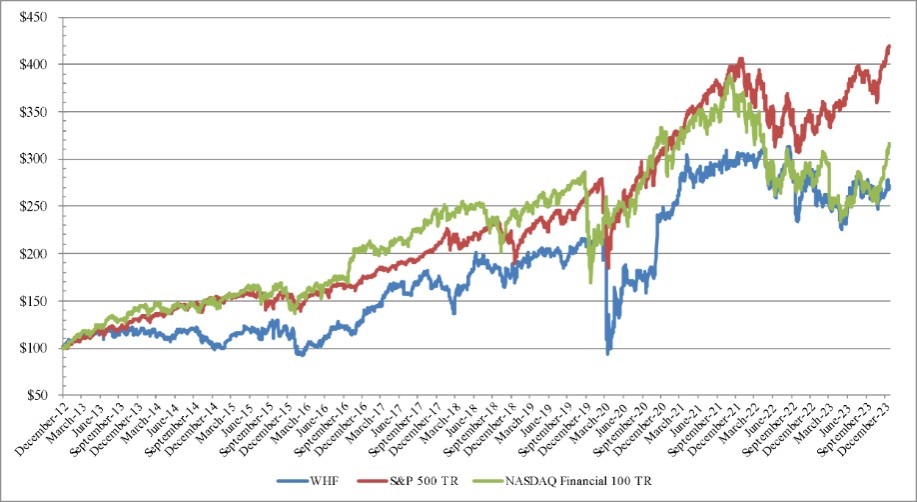companies by fair value in STRS JV totaled $83,564 and $77,635 as of December 31, 2023 and December 31, 2022, respectively. STRS JV invests in portfolio companies in the same industries in which the Company may directly invest.
The Company provides capital to STRS JV in the form of LLC equity interests and through interest-bearing subordinated notes. As of December 31, 2023, the Company and STRS Ohio owned 65.71% and 34.29%, respectively, of the LLC equity interests of STRS JV. As of December 31, 2022, the Company and STRS Ohio owned 66.67% and 33.33%, respectively, of the LLC equity interests of STRS JV. The Company’s investment in STRS JV consisted of equity contributions of $21,104 and $20,000 and advances of the subordinated notes of $84,416 and $80,000 as of December 31, 2023 and December 31, 2022, respectively. As of December 31, 2023, the Company had commitments to fund equity interests and subordinated notes in STRS JV of $23,000 and $92,000, respectively, of which $1,896 and $7,584 were unfunded, respectively. As of December 31, 2022, the Company had commitments to fund equity interests and subordinated notes in STRS JV of $20,000 and $90,000, respectively, both of which were fully funded.
The Company and STRS Ohio each appoint two members to STRS JV’s four-person board of managers. All material decisions with respect to STRS JV, including those involving its investment portfolio, require unanimous approval of a quorum of the board of managers. Quorum is defined as (i) the presence of two members of the board of managers; provided that at least one individual is present that was elected, designated or appointed by each member; (ii) the presence of three members of the board of managers; provided that the individual that was elected, designated or appointed by the member with only one individual present shall be entitled to cast two votes on each matter; or (iii) the presence of four members of the board of managers; provided that two individuals are present that were elected, designated or appointed by each member.
On July 19, 2019, STRS JV entered into a $125,000 credit and security agreement (the “STRS JV Credit Facility”) with JPMorgan Chase Bank, National Association (“JPMorgan”). On January 27, 2021, the terms of the STRS JV Credit Facility were amended to, among other things, increase the size of the STRS JV Credit Facility from $125,000 to $175,000. On April 28, 2021, the terms of the STRS JV Credit Facility were amended and restated to, among other things, enable borrowings in British pounds or euros. On July 15, 2021, the terms of the STRS JV Credit Facility were amended to, among other things, allow STRS JV to reduce the applicable margins for interest rates to 2.35%, extend the non-call period from January 19, 2022 to January 19, 2023, extend the end of the reinvestment period from July 19, 2022 to July 19, 2023 and extend the scheduled termination date from July 19, 2024 to July 19, 2025.
On March 11, 2022, the terms of the STRS JV Credit Facility were further amended to, among other things, (i) permanently increase STRS Credit’s availability under the Credit Facility from $175,000 to $225,000, (ii) increase the minimum funding amount from $131,250 to $168,750, and (iii) apply an annual interest rate equal to the applicable SOFR plus 2.50% to borrowings greater than $175,000 in the Credit Facility.
On January 13, 2023, the terms of the STRS JV Credit Facility were further amended to, among other things, (i) permanently increase STRS Credit’s availability under the STRS JV Credit Facility from $225,000 to $262,500 (the “$37.5 Million Increase”) and (ii) apply an annual interest rate equal to applicable SOFR, plus 3.00% to any borrowings under the $37.5 Million Increase in the STRS JV Credit Facility.
On May 18, 2023, the terms of the STRS JV Credit Facility were further amended to, among other things, (i) effective June 6, 2023 apply an annual interest rate equal to applicable SOFR plus 2.72% to any USD borrowings, (ii) extend the scheduled termination date from July 19, 2025 to July 19, 2026, (iii) extend the non-call period from January 19, 2023 to January 19, 2024 and (iv) extend the end of the reinvestment period from July 19, 2023 to July 19, 2024.
As of December 31, 2023, the STRS JV Credit Facility had $262,500 of commitments subject to leverage and borrowing base restrictions with an interest rate based on a risk-free index rate such as SOFR plus 2.72%, Euro Interbank Offered Rate (“EurIBOR”), SONIA or CDOR plus a spread of 2.35%. The final maturity date of the STRS JV Credit Facility is July 19, 2026. As of December 31, 2023, STRS JV had $165,244 of outstanding borrowings and an interest rate outstanding of 7.7% per annum under the STRS JV Credit Facility.

